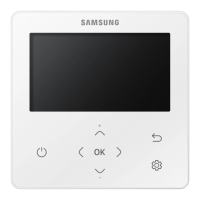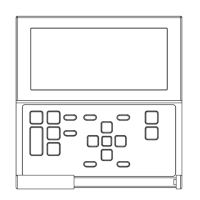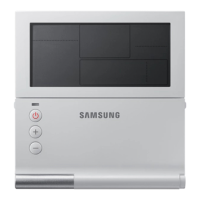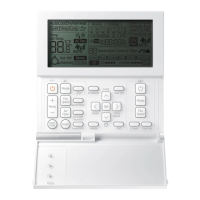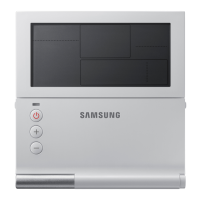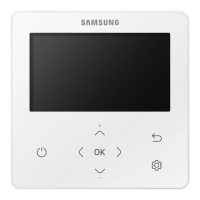What happens if the PHE Outlet thermistor is SHORT or OPEN in my Samsung Heat Pump?
- LLisa JamesAug 4, 2025
If the PHE Outlet thermistor is SHORT or OPEN, error codes will be displayed on the wired remote controller.
What happens if the PHE Outlet thermistor is SHORT or OPEN in my Samsung Heat Pump?
If the PHE Outlet thermistor is SHORT or OPEN, error codes will be displayed on the wired remote controller.
What happens if the Zone1 Water Outlet Thermistor is SHORT or OPEN in my Samsung Heat Pump?
If the Zone1 Water Outlet Thermistor is SHORT or OPEN, error codes will be displayed on the wired remote controller.
What happens if the Zone 2 Water Outlet Thermistor is SHORT or OPEN in my Samsung Heat Pump?
If the Zone 2 Water Outlet Thermistor is SHORT or OPEN, error codes will be displayed on the wired remote controller.
Covers warnings and cautions for general operation, installation, and power supply.
Details safety guidelines specific to appliance installation by qualified personnel.
Outlines warnings related to the proper handling and use of the power cord.
Covers safety instructions for operating the unit and cleaning procedures.
Explains how to use Auto, Cool, and Heat modes via the remote controller.
Details the operation and settings for the Domestic Hot Water function.
Describes how to adjust desired temperatures and set specific temperature values.
Explains how to view the current operational status of the unit's various functions.
Covers Quiet mode for noise reduction and Outing mode for low-temperature operation.
Guide to configuring daily, weekly, and yearly schedules for unit operation.
Details how to view and set energy consumption targets and operation times.
Explains Time-Division Multi variables for managing simultaneous A2A and A2W operations.
Provides steps for navigating and setting various operational options.
Describes how to lock buttons and view a list of system errors.
Information related to the indoor unit's status and configuration.
Settings related to user mode, including language, daylight saving, and lock functions.
Configuration options for the wired remote controller, including LED, time, and display.
Options for resetting user modes and checking service call history.
Step-by-step guide for setting the current time on the remote controller.
Accessing advanced functions requiring password entry and specific settings.
Settings for service timers and automatic activation of quiet mode.
Settings related to indoor zone selection, temperature, and sensor configuration.
Details on indoor zone status, connection methods, and master zone information.
Information about device components, reset procedures, and power master settings.
Procedures for managing field setting values, including resets and K3 reset.
How to display the self-test mode for various unit components.
Settings and controls for individual components like pumps, valves, and heaters.
Configuration options for indoor units, including addresses and MCU port settings.
Guide on how to upload or download field settings using an SD card.
Identifies applicable models for specific field setting configurations.
Important cautions and notes regarding field setting value adjustments.
Introduction to Field Setting Value (FSV) Code 10** for remote controller settings.
Detailed ranges and default values for cooling, heating, and DHW settings.
Overview of Field Setting Value (FSV) Code 20** for water law and thermostat types.
Explanation of water law logic and room thermostat settings for Code 20**.
Configuration for using external room thermostats with the system.
Details on Field Setting Value (FSV) Code 30** for domestic hot water tank heating options.
Specifics on DHW application and heat pump variables for tank temperature control.
Diagrams and explanations for DHW tank temperature thermo on/off control.
Management of operation times when DHW and space heating requests are simultaneous.
Controls for heat pump and booster heater operation timing in DHW modes.
Illustrative examples of using the Booster Heater (BSH) for hot water supply.
Explanation of thermo on/off control for heat pump and booster heater.
Setup and scheduling for the hot water tank disinfection function.
Options for forced DHW modes and installation of solar/DHW thermostats.
How to set capacities for accurate energy consumption metering.
Introduction to Field Setting Value (FSV) Code 40** for heating device options.
Configuration of heat pump performance for space heating under various conditions.
Settings for backup heater usage and cold weather compensation in space heating.
Option to use an external backup boiler as an additional heat source.
How to install and configure the mixing valve based on temperature differences.
Settings for inverter pump usage, output, and temperature difference adjustment.
Configuration for zone control using the wired remote controller or thermostat.
Introduction to Field Setting Value (FSV) Code 50** for various extra functions.
Setting target temperatures for different modes when the "Outing" function is active.
Settings for energy-saving DHW heating using heat pump and saving modes.
Options to limit power consumption based on electric power company contracts.
Methods for limiting the maximum frequency of the outdoor unit compressor.
Setting up energy saving using solar energy via PV control.
Configuration for smart grid control, including operation modes and input voltage.
Specific field setting values for DVM Hydro unit models AM****NBD***.
Settings for disinfection, heating, outing mode, and economic DHW modes.
Specific field setting values for DVM Hydro unit HT models AM***TNBF**.
Detailed water law logic and DHW settings for various modes.
Lists functions that require setting based on field specifications for Code 10**.
Explanation of water law logic and related settings for Code 20**.
User options for domestic hot water (DHW) tank heating control using Code 30**.
Timing controls for DHW operation, disinfection, and priority settings.
Settings for priority between space/DHW heating and related control variables.
User options for various extra functions, including Smart Grid and power control.
Guidelines for regular checks and inspections to ensure optimal unit availability.
Procedures for enabling emergency heating or hot water when the outdoor unit malfunctions.
Explanations of error codes displayed on the wired remote controller.
Explains errors related to low flow rate and normal flow rate for the water pump.
Details on communication errors between the remote controller and the Hydro unit.
Lists error codes originating from the Hydro Unit and Outdoor Unit.
Detailed error codes related to the Outdoor Unit's components and operations.
Error codes pertaining to Hydro Unit and Wired Remote Controller communication.
Additional error codes related to Hydro Unit sensors and FSV data.
Covers warnings and cautions for general operation, installation, and power supply.
Details safety guidelines specific to appliance installation by qualified personnel.
Outlines warnings related to the proper handling and use of the power cord.
Covers safety instructions for operating the unit and cleaning procedures.
Explains how to use Auto, Cool, and Heat modes via the remote controller.
Details the operation and settings for the Domestic Hot Water function.
Describes how to adjust desired temperatures and set specific temperature values.
Explains how to view the current operational status of the unit's various functions.
Covers Quiet mode for noise reduction and Outing mode for low-temperature operation.
Guide to configuring daily, weekly, and yearly schedules for unit operation.
Details how to view and set energy consumption targets and operation times.
Explains Time-Division Multi variables for managing simultaneous A2A and A2W operations.
Provides steps for navigating and setting various operational options.
Describes how to lock buttons and view a list of system errors.
Information related to the indoor unit's status and configuration.
Settings related to user mode, including language, daylight saving, and lock functions.
Configuration options for the wired remote controller, including LED, time, and display.
Options for resetting user modes and checking service call history.
Step-by-step guide for setting the current time on the remote controller.
Accessing advanced functions requiring password entry and specific settings.
Settings for service timers and automatic activation of quiet mode.
Settings related to indoor zone selection, temperature, and sensor configuration.
Details on indoor zone status, connection methods, and master zone information.
Information about device components, reset procedures, and power master settings.
Procedures for managing field setting values, including resets and K3 reset.
How to display the self-test mode for various unit components.
Settings and controls for individual components like pumps, valves, and heaters.
Configuration options for indoor units, including addresses and MCU port settings.
Guide on how to upload or download field settings using an SD card.
Identifies applicable models for specific field setting configurations.
Important cautions and notes regarding field setting value adjustments.
Introduction to Field Setting Value (FSV) Code 10** for remote controller settings.
Detailed ranges and default values for cooling, heating, and DHW settings.
Overview of Field Setting Value (FSV) Code 20** for water law and thermostat types.
Explanation of water law logic and room thermostat settings for Code 20**.
Configuration for using external room thermostats with the system.
Details on Field Setting Value (FSV) Code 30** for domestic hot water tank heating options.
Specifics on DHW application and heat pump variables for tank temperature control.
Diagrams and explanations for DHW tank temperature thermo on/off control.
Management of operation times when DHW and space heating requests are simultaneous.
Controls for heat pump and booster heater operation timing in DHW modes.
Illustrative examples of using the Booster Heater (BSH) for hot water supply.
Explanation of thermo on/off control for heat pump and booster heater.
Setup and scheduling for the hot water tank disinfection function.
Options for forced DHW modes and installation of solar/DHW thermostats.
How to set capacities for accurate energy consumption metering.
Introduction to Field Setting Value (FSV) Code 40** for heating device options.
Configuration of heat pump performance for space heating under various conditions.
Settings for backup heater usage and cold weather compensation in space heating.
Option to use an external backup boiler as an additional heat source.
How to install and configure the mixing valve based on temperature differences.
Settings for inverter pump usage, output, and temperature difference adjustment.
Configuration for zone control using the wired remote controller or thermostat.
Introduction to Field Setting Value (FSV) Code 50** for various extra functions.
Setting target temperatures for different modes when the "Outing" function is active.
Settings for energy-saving DHW heating using heat pump and saving modes.
Options to limit power consumption based on electric power company contracts.
Methods for limiting the maximum frequency of the outdoor unit compressor.
Setting up energy saving using solar energy via PV control.
Configuration for smart grid control, including operation modes and input voltage.
Specific field setting values for DVM Hydro unit models AM****NBD***.
Settings for disinfection, heating, outing mode, and economic DHW modes.
Specific field setting values for DVM Hydro unit HT models AM***TNBF**.
Detailed water law logic and DHW settings for various modes.
Lists functions that require setting based on field specifications for Code 10**.
Explanation of water law logic and related settings for Code 20**.
User options for domestic hot water (DHW) tank heating control using Code 30**.
Timing controls for DHW operation, disinfection, and priority settings.
Settings for priority between space/DHW heating and related control variables.
User options for various extra functions, including Smart Grid and power control.
Guidelines for regular checks and inspections to ensure optimal unit availability.
Procedures for enabling emergency heating or hot water when the outdoor unit malfunctions.
Explanations of error codes displayed on the wired remote controller.
Explains errors related to low flow rate and normal flow rate for the water pump.
Details on communication errors between the remote controller and the Hydro unit.
Lists error codes originating from the Hydro Unit and Outdoor Unit.
Detailed error codes related to the Outdoor Unit's components and operations.
Error codes pertaining to Hydro Unit and Wired Remote Controller communication.
Additional error codes related to Hydro Unit sensors and FSV data.
| Brand | Samsung |
|---|---|
| Model | MWR-WW10N |
| Category | Remote Control |
| Language | English |
